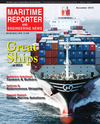
Page 42: of Maritime Reporter Magazine (December 2015)
Great Ships of 2015
Read this page in Pdf, Flash or Html5 edition of December 2015 Maritime Reporter Magazine
To be or not to be Green ...
There is no Question oday’s maritime climate (all puns intended) is fraught with opportunities and challenges. On the one hand, many sectors of the marine industry still struggle in the wake of the Great Recession (with some notable petroleum and cruise line exceptions) while also facing multiple regulations intended to protect our marine environment. On the other, there remains confusion and discord on how imple-
T mentation should be achieved.
Unifying regulations are required for a global industry such as ours. I believe the shipowning community would be satis? ed, if not pleased, to invest in technology and training to meet regulatory requirements if the regulations were consistently applied and enforced. No commercial operator wants to play on an uneven play- ing ? eld, investing in equipment that may not be approved in future years, or a port state that isn’t enforcing said regulations.
There exists a need for investment in developing technologies. Traditionally, only the largest shipowners and cruise lines have had the ? nancial resources to fund experimental technology. More ? nancing for research and development is needed, either through the capital markets, governments, educational facilities or founda- tions that are willing to invest in this area (think how the Ford Foundation and others saved Detroit. It could happen in shipping).
Innovation is the key to addressing these issues. In an industry that does not change quickly, we need to adapt to a faster pace of development driven, in part, by our Internet age. In a culture that is looking at driver- less cars (and ships) we need to be responsive to the public’s demand for protecting our environment.
Communications are instantaneous and global. Social media has connected activists with the public in unprecedented numbers—and they are good at it. If we are not demonstrate strong initiatives to address envi- ronmental concerns, our in? uence over regulatory factors will diminish. It only takes one incident, or negative sound bite, to in? uence public opinion against our industry. We need to be vigilant about unifying our regula- tions and developing technologies to support them.
When you examine some of the current regulations, many key factors stand out:
MARPOL I
After nearly 25 years of active enforcement by the Department of Justice, and the vast improvements in tech- nologies, why, then, do we continue to see Oily Water Separator violations? This is a puzzling question, and makes one think that training is at the root of the problem? Excellent products exist on the market, complete with enforcement mechanisms and tools. Yet there are ongoing efforts to violate MARPOL I by dumping oil at sea.
MARPOL V
The relatively recent bolstering of this Annex has turned the focus onto the need for the development and deployment of waste stream solutions. Ships need to have safe and affordable options for disposing of their wastes at port. It is not feasible to either move a vessel, or to charge unreasonable rates for disposal because of a “captive” audience. It seems to me that there is a market opportunity here…
MARPOL VI
After many years of staying under the radar, shipping’s role in carbon emissions took the stage this month in
Paris at the UNFCCC (United Nations Framework Convention on Climate Change) meeting in Paris. De- spite shipping’s strides in the past few years to reduce its carbon footprint, as well as having the only global, legally binding energy ef? ciency measures, the impact of the industry’s carbon output (roughly the same as
Germany’s) was illuminated, with groups actively advocating for shipping to be held accountable for greater reductions. At COP21, the IMO representative Edmund Hughes said he could see “no technological or in- novative response that could be applied to a large bulker operating in the North Atlantic in deep winter. These vessels were effectively mobile power stations and no change could be envisaged in the next 20-30 years.”
Clearly this is not going to be acceptable to the global climate community and will lead to harsh pressure on our industry going forward.
Other areas of opportunity and challenge pertain to ballast water management, bio-fouling, aquatic noise, implementation of the Maritime Labor Convention (yes, crew welfare IS an environmental issue when we look at safety at sea), non-vessel source pollution and others. The maritime agenda is full.
The Author
Happy Holidays,
Carleen Lyden-Kluss is Co-Founder/Executive Director of the
North American Marine Environment Protection Association (NAMEPA) and CEO of Morgan Marketing & Communica-
Carleen Lyden-Kluss tions. She was recently selected as an IMO Ambassador.
Co-Founder/Executive Director
North American Marine Environment Protection Association (NAMEPA) 42 Maritime Reporter & Engineering News • DECEMBER 2015
MR #12 (41-49).indd 42 12/7/2015 2:40:30 PM

 41
41

 43
43
